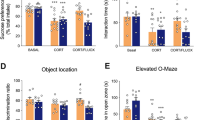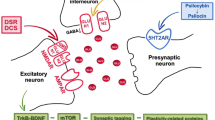Abstract
Depression is a major health problem worldwide. Most prescribed anti-depressants, the selective serotonin reuptake inhibitors (SSRI) show limited efficacy and delayed onset of action, partly due to the activation of somatodendritic 5-HT1A-autoreceptors by the excess extracellular serotonin (5-HT) produced by SSRI in the raphe nuclei. Likewise, 5-HT1A receptor (5-HT1AR) gene polymorphisms leading to high 5-HT1A-autoreceptor expression increase depression susceptibility and decrease treatment response. In this study, we report on a new treatment strategy based on the administration of small-interfering RNA (siRNA) to acutely suppress 5-HT1A-autoreceptor-mediated negative feedback mechanisms. We developed a conjugated siRNA (C-1A-siRNA) by covalently binding siRNA targeting 5-HT1A receptor mRNA with the SSRI sertraline in order to concentrate it in serotonin axons, rich in serotonin transporter (SERT) sites. The intracerebroventricular (i.c.v.) infusion of C-1A-siRNA to mice resulted in its selective accumulation in serotonin neurons. This evoked marked anti-depressant-like effects in the forced swim and tail suspension tests, but did not affect anxiety-like behaviors in the elevated plus-maze. In parallel, C-1A-siRNA administration markedly decreased 5-HT1A-autoreceptor expression and suppressed 8-OH-DPAT-induced hypothermia (a pre-synaptic 5-HT1AR effect in mice) without affecting post-synaptic 5-HT1AR expression in hippocampus and prefrontal cortex. Moreover, i.c.v. C-1A-siRNA infusion augmented the increase in extracellular serotonin evoked by fluoxetine in prefrontal cortex to the level seen in 5-HT1AR knockout mice. Interestingly, intranasal C-1A-siRNA administration produced the same effects, thus opening the way to the therapeutic use of C-1A-siRNA. Hence, C-1A-siRNA represents a new approach to treat mood disorders as monotherapy or in combination with SSRI.
This is a preview of subscription content, access via your institution
Access options
Subscribe to this journal
Receive 12 print issues and online access
$259.00 per year
only $21.58 per issue
Buy this article
- Purchase on Springer Link
- Instant access to full article PDF
Prices may be subject to local taxes which are calculated during checkout





Similar content being viewed by others
Accession codes
References
Andlin-Sobocki P, Jönsson B, Wittchen HU, Olesen J . Cost of disorders of the brain in Europe. Eur J Neurol 2005; 12: 1–27.
Krishnan V, Nestler EJ . The molecular neurobiology of depression. Nature 2008; 455: 894–902.
Murray CJL, López AD . Alternative projections of mortality and disability by cause 1990–2020: Global Burden of Disease Study. Lancet 1997; 34: 1498–1504.
Piñeyro G, Blier P . Autoregulation of serotonin neurons: role in antidepressant drug action. Pharmacol Rev 1999; 51: 533–591.
Blier P, de Montigny C . Current advances and trends in the treatment of depression. Trends Pharmacol Sci 1994; 15: 220–226.
Artigas F, Romero L, de Montigny C, Blier P . Acceleration of the effect of selected antidepressant drugs in major depression by 5-HT1A antagonists. Trends Neurosci 1996; 19: 378–383.
Lemonde S, Turecki G, Bakish D, Du L, Hrdina PD et al. Impaired repression at 5-hydroxytryptamine1A receptor gene polymorphism associated with major depression and suicide. J Neurosci 2003; 23: 8788–8799.
Neff CD, Abkevich V, Packer JC, Chen Y, Potter J et al. Evidence for HTR1A and LHPP as interacting genetic risk factors in major depression. Mol Psychiatry 2009; 14: 621–630.
Stockmeier CA, Shapiro LA, Dilley GE, Kolli TN, Friedman L et al. Increase in serotonin-1A autoreceptors in the midbrain of suicide victims with major depression-postmortem evidence for decreased serotonin activity. J Neurosci 1998; 18: 7394–7401.
Haddjeri N, Blier P, de Montigny C . Long-term antidepressant treatments result in a tonic activation of forebrain 5-HT1A receptors. J Neurosci 1998; 18: 10150–10156.
Artigas F, Peréz V, Alvaréz E . Pindolol induces a rapid improvement of depressed patients treated with serotonin reuptake inhibitors. Arch Gen Psychiatry 1994; 51: 248–251.
Artigas F, Celada P, Laruelle M, Adell A . How does pindolol improve antidepressant action? Trends Pharmacol Sci 2001; 22: 224–228.
Martinez D, Hwang D, Mawlawi O, Slifstein M, Kent J et al. Differential occupancy of somatodendritic and postsynaptic 5HT(1A) receptors by pindolol: a dose-occupancy study with [11C]WAY 100635 and positron emission tomography in humans. Neuropsychoparmacology 2001; 24: 209–229.
Serrats J, Artigas F, Mengod G, Cortés R . An autoradiographic study of the influence of pindolol upon [35S]GTPgammaS binding in rat, guinea pig and human brain. Int J Neuropsychopharmacol 2004; 7: 27–34.
Parks CL, Robinson PS, Sibille E, Shenk T, Toth M . Increased anxiety of mice lacking the serotonin1A receptor. Proc Natl Acad Sci USA 1998; 95: 10734–10739.
McBride LJ, Caruthers MH . An investigation of several deoxynucleoside phosphoramidites useful for synthesizing deoxyoligonucleotides. Tetrahedron Lett 1983; 24: 245–248.
Kurreck J, Wyszko E, Gillen C, Erdmann VA . Design of antisense oligonucleotides stabilized by locked nucleic acids. Nucleic Acids Res 2002; 30: 1911–1918.
Judge AD, Sood V, Shaw JR, Fang D, McClintock K, MacLachlan I . Sequence-dependent stimulation of the mammalian innate immune response by synthetic siRNA. Nat Biotechnol 2005; 23: 457–462.
Franklin KBJ, Paxinos G . The Mouse Brain in Stereotaxic Coordinates,, Compact 3rd edn Academic Press: New York, USA, 2008.
Amargós-Bosch M, Bortolozzi A, Puig MV, Serrats J, Adell A et al. Co-expression and in vivo interaction of serotonin1A and serotonin2A receptors in pyramidal neurons of prefrontal cortex. Cereb Cortex 2004; 14: 281–299.
Pompeiano M, Palacios JM, Mengod G . Distribution and cellular localization of mRNA coding for 5-HT1A receptor in the rat brain: correlation with receptor binding. J Neurosci 1992; 12: 440–453.
Santana N, Bortolozzi A, Serrats J, Mengod G, Artigas F . Expression of serotonin1A and serotonin2A receptors in pyramidal and GABAergic neurons of the rat prefrontal cortex. Cereb Cortex 2004; 14: 1100–1109.
D’Amato RJ, Largent BL, Snowman AM, Snyder SH . Selective labeling of serotonin uptake sites in rat brain by [3H]citalopram contrasted to labeling of multiple sites by [3H]imipramine. J Pharmacol Exp Ther 1987; 242: 364–371.
Pazos A, Palacios JM . Quantitative autoradiographic mapping of serotonin receptors in the rat brain. I. Serotonin-1 receptors. Brain Res 1985; 346: 205–230.
Adell A, Celada P, Abellán MT, Artigas F . Origin and functional role of the extracellular serotonin in the midbrain raphe nuclei. Brain Res Rev 2002; 39: 154–180.
Porsolt RD, Bertin A, Jalfre M . Behavioural despair in rats and mice: strain differences and the effects of imipramine. European J Pharmacol 1978; 51: 291–294.
Baker M . RNA intereference: homing in on delivery. Nature 2010; 464: 1225–1228.
López-Gil X, Bortolozzi A, Castañé A, Santana N, Cortés R et al. Selective in vivo knockdown of mouse presynaptic 5-HT1A receptors using RNA interference,. 39th Annual Meeting of the Society for Neuroscience 2009; abstract 342.7.
Beaudet A, Descarries L . Quantitative data on serotonin nerve terminals in adult rat neocortex. Brain Res 1976; 111: 301–309.
Martin KF, Phillips I, Hearson M, Prow MR, Heal DJ . Characterization of 8-OH-DPAT-induced hypothermia in mice as a 5-HT1A autoreceptor response and its evaluation as a model to selectively identify antidepressants. Br J Pharmacol 1992; 107: 15–21.
Ramboz S, Oosting R, Amara DA, Kung HF, Blier P et al. Serotonin receptor 1A knockout: an animal model of anxiety-related disorder. Proc Natl Acad Sci USA 1998; 95: 14476–14481.
Illum L . Transport of drugs from the nasal cavity to the central nervous system. Eur J Pharm Sci 2000; 11: 1–18.
Marks DR, Tucker K, Cavallin MA, Mast TG, Fadool DA . Awake intranasal insulin delivery modifies protein complexes and alters memory, anxiety, and olfactory behaviors. J Neurosci 2009; 29: 6734–6751.
Yamada M, Chiba T, Sasabe J, Terashita K, Aiso S, Matsuoka M . Nasal Colivelin treatment ameliorates memory impairment related to Alzheimer's disease. Neuropsychopharmacology 2008; 33: 2020–2032.
Ramamoorthy S, Blakely RD . Phosphorylation and sequestration of serotonin transporters differentially modulated by psychostimulants. Science 1999; 285: 763–766.
Kumar P, Wu H, McBride JL, Jung KE, Kim MH et al. Transvascular delivery of small interfering RNA to the central nervous system. Nature 2007; 448: 39–43.
Song E, Zhu P, Lee SK, Chowdhury D, Kussman S et al. Antibody mediated in vivo delivery of small interfering RNAs via cell-surface receptors. Nat Biotechnol 2005; 23: 709–717.
Soutschek J, Akinc A, Bramlage B, Charisse K, Constien R et al. Therapeutic silencing of an endogenous gene by systemic administration of modified siRNAs. Nature 2004; 432: 173–178.
Thakker DR, Natt F, Hüsken D, Maier R, Müller M et al. Neurochemical and behavioral consequences of widespread gene knockdown in the adult mouse brain by using nonviral RNA interference. Proc Natl Acad Sci USA 2004; 101: 17270–17275.
Thakker DR, Natt F, Hüsken D, van der Putten H, Maier R et al. siRNA-mediated knockdown of the serotonin transporter in the adult mouse brain. Mol Psychiatry 2005; 10: 782–789.
Fakra E, Hyde LW, Gorka A, Fisher PM, Muñoz KE et al. Effects of HTR1A C(-1019)G on amygdala reactivity and trait anxiety. Arch Gen Psychiatry 2009; 66: 33–40.
Ballesteros J, Callado LF . Effectiveness of pindolol plus serotonin uptake inhibitors in depression: a meta-analysis of early and late outcomes from randomized controlled trials. J Affect Disord 2004; 79: 137–147.
Richardson-Jones JW, Craige CP, Guiard BP, Stephen A, Metzger KL et al. 5-HT1A autoreceptor levels determine vulnerability to stress and response to antidepressants. Neuron 2010; 65: 40–52.
Gleason G, Liu B, Bruening S, Zupan B, Auerbach A et al. The serotonin1A receptor gene as a genetic and prenatal maternal environmental factor in anxiety. Proc Natl Acad Sci USA 2010; 107: 7592–7597.
McLean JH, Shipley MT . Serotonergic afferents to the rat olfactory bulb: I. Origins and laminar specificity of serotonergic inputs in the adult rat. J Neurosci 1987; 7: 3016–3028.
Acknowledgements
We thank Leticia Campa for skillful work with HPLC equipment, and Verónica Paz and Noemí Jurado for technical assistance. This study was supported by grants from Spanish Ministry of Science and Innovation SAF2007-62378 and CDTI, with the participation of the DENDRIA Consortium; from Spanish Ministry of Health, Instituto de Salud Carlos III PI10/00290 and Centro de Investigación Biomédica en Red de Salud Mental, CIBERSAM; and a research contract CSIC-IDIBAPS with NEDKEN, SL-nLife Therapeutics, SL Support from the Innovative Medicines Initiative Joint Undertaking (IMI) under Grant Agreement N° 115008 (NEWMEDS) is also acknowledged. IMI is a public-private partnership between the European Union and the European Federation of Pharmaceutical Industries and Associations. AB is supported by the Research stabilization Program of the Health Department of the Generalitat de Catalunya. AM is a cofounder and board member of nLife Therapeutics, SL GA, GF and MCC are employees of nLife Therapeutics, SL.
Author information
Authors and Affiliations
Corresponding authors
Ethics declarations
Competing interests
The authors declare no conflict of interest.
Additional information
Supplementary Information accompanies the paper on the Molecular Psychiatry website
Supplementary information
Rights and permissions
About this article
Cite this article
Bortolozzi, A., Castañé, A., Semakova, J. et al. Selective siRNA-mediated suppression of 5-HT1A autoreceptors evokes strong anti-depressant-like effects. Mol Psychiatry 17, 612–623 (2012). https://doi.org/10.1038/mp.2011.92
Received:
Revised:
Accepted:
Published:
Issue Date:
DOI: https://doi.org/10.1038/mp.2011.92
Keywords
This article is cited by
-
Dual HDAC–BRD4 inhibitors endowed with antitumor and antihyperalgesic activity
Medicinal Chemistry Research (2022)
-
Dual HDAC/BRD4 Inhibitors Relieves Neuropathic Pain by Attenuating Inflammatory Response in Microglia After Spared Nerve Injury
Neurotherapeutics (2022)
-
Antidepressant-Like Effects of CX717, a Positive Allosteric Modulator of AMPA Receptors
Molecular Neurobiology (2020)
-
β-Catenin Role in the Vulnerability/Resilience to Stress-Related Disorders Is Associated to Changes in the Serotonergic System
Molecular Neurobiology (2020)
-
Selective Knockdown of TASK3 Potassium Channel in Monoamine Neurons: a New Therapeutic Approach for Depression
Molecular Neurobiology (2019)



